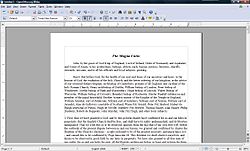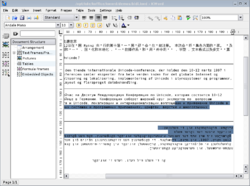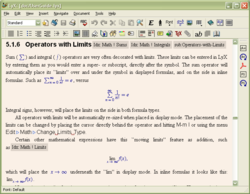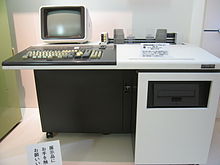- Word processor
-
A word processor is a computer application used for the production (including composition, editing, formatting, and possibly printing) of any sort of printable material.
Word processor may also refer to a type of stand-alone office machine, popular in the 1970s and 1980s, combining the keyboard text-entry and printing functions of an electric typewriter with a dedicated processor (like a computer processor) for the editing of text. Although features and design varied between manufacturers and models, with new features added as technology advanced, word processors for several years usually featured a monochrome display and the ability to save documents on memory cards or diskettes. Later models introduced innovations such as spell-checking programs, increased formatting options, and dot-matrix printing. As the more versatile combination of a personal computer and separate printer became commonplace, most business-machine companies stopped manufacturing the word processor as a stand-alone office machine. As of 2009 there were only two U.S. companies, Classic and AlphaSmart, which still made stand-alone word processors.[1] Many older machines, however, remain in use. Since 2009, Sentinel has offered a machine described as a word processor, but in actuality it is more accurately a highly specialised microcomputer, used for accounting and publishing.[2]
Word processors are descended from early text formatting tools (sometimes called text justification tools, from their only real capability). Word processing was one of the earliest applications for the personal computer in office productivity.
Although early word processors used tag-based markup for document formatting, most modern word processors take advantage of a graphical user interface providing some form of what-you-see-is-what-you-get editing. Most are powerful systems consisting of one or more programs that can produce any arbitrary combination of images, graphics and text, the latter handled with type-setting capability.
Microsoft Word is the most widely used word processing software. Microsoft estimates that over 500,000,000 people use the Microsoft Office suite,[3] which includes Word. Many other word processing applications exist, including WordPerfect (which dominated the market from the mid-1980s to early-1990s on computers running Microsoft's MS-DOS operating system) and open source applications OpenOffice.org Writer, AbiWord, KWord, and LyX. Web-based word processors, such as Office Web Apps or Google Docs, are a relatively new category.
Contents
Characteristics
Word processing typically implies the presence of text manipulation functions that extend beyond a basic ability to enter and change text, such as automatic generation of:
- batch mailings using a form letter template and an address database (also called mail merging);
- indices of keywords and their page numbers;
- tables of contents with section titles and their page numbers;
- tables of figures with caption titles and their page numbers;
- cross-referencing with section or page numbers;
- footnote numbering;
- new versions of a document using variables (e.g. model numbers, product names, etc.)
Other word processing functions include spell checking (actually checks against wordlists), "grammar checking" (checks for what seem to be simple grammar errors), and a "thesaurus" function (finds words with similar or opposite meanings). Other common features include collaborative editing, comments and annotations, support for images and diagrams and internal cross-referencing.
Word processors can be distinguished from several other, related forms of software:
Text editors were the precursors of word processors. While offering facilities for composing and editing text, they do not format documents. This can be done by batch document processing systems, starting with TJ-2 and RUNOFF and still available in such systems as LaTeX (as well as programs that implement the paged-media extensions to HTML and CSS). Text editors are now used mainly by programmers, website designers, computer system administrators, and, in the case of LaTeX by mathematicians and scientists (for complex formulas and for citations in rare languages). They are also useful when fast startup times, small file sizes, editing speed and simplicity of operation are preferred over formatting.
Later desktop publishing programs were specifically designed to allow elaborate layout for publication, but often offered only limited support for editing. Typically, desktop publishing programs allowed users to import text that was written using a text editor or word processor.
Almost all word processors enable users to employ styles, which are used to automate consistent formatting of text body, titles, subtitles, highlighted text, and so on.
Styles greatly simplify managing the formatting of large documents, since changing a style automatically changes all text that the style has been applied to. Even in shorter documents styles can save a lot of time while formatting. However, most help files refer to styles as an 'advanced feature' of the word processor, which often discourages users from using styles regularly.
Document statistics
Most current word processors can calculate various statistics pertaining to a document. These usually include:
- Character count, word count, sentence count, line count, paragraph count, page count.
- Word, sentence and paragraph length.
- Editing time.
Errors are common; for instance, a dash surrounded by spaces — like either of these — may be counted as a word.
Typical usage
Word processors have a variety of uses and applications within the business world, home, and education.
Business
Within the business world, word processors are extremely useful tools. Typical uses include:
- legal copies
- letters and letterhead
- memos
- reference documents
Businesses tend to have their own format and style for any of these. Thus, versatile word processors with layout editing and similar capabilities find widespread use in most businesses.
Education
Many schools have begun to teach typing and word processing to their students, starting as early as elementary school. Typically these skills are developed throughout secondary school in preparation for the business world. Undergraduate students typically spend many hours writing essays. Graduate and doctoral students continue this trend, as well as creating works for research and publication.
Home
While many homes have word processors on their computers, word processing in the home tends to be educational, planning or business related, dealing with assignments or work being completed at home, or occasionally recreational, e.g. writing short stories. Some use word processors for letter writing, résumé creation, and card creation. However, many of these home publishing processes have been taken over by desktop publishing programs specifically oriented toward home use which are better suited to these types of documents.
History
The term word processing was invented by IBM in the late 1960s. By 1971 it was recognized by the New York Times as a "buzz word".[4] A 1974 Times article referred to "the brave new world of Word Processing or W/P. That's International Business Machines talk... I.B.M. introduced W/P about five years ago for its Magnetic Tape Selectric Typewriter and other electronic razzle-dazzle."[5]
IBM defined the term in a broad and vague way as "the combination of people, procedures, and equipment which transforms ideas into printed communications," and originally used it to include dictating machines and ordinary, manually-operated Selectric typewriters.[6] By the early seventies, however, the term was generally understood to mean semiautomated typewriters affording at least some form of electronic editing and correction, and the ability to produce perfect "originals." Thus, the Times headlined a 1974 Xerox product as a "speedier electronic typewriter", but went on to describe the product, which had no screen,[7] as "a word processor rather than strictly a typewriter, in that it stores copy on magnetic tape or magnetic cards for retyping, corrections, and subsequent printout."[8]
Electromechanical paper-tape-based equipment such as the Friden Flexowriter had long been available; the Flexowriter allowed for operations such as repetitive typing of form letters (with a pause for the operator to manually type in the variable information),[9] and when equipped with an auxiliary reader, could perform an early version of "mail merge". Circa 1970 it began to be feasible to apply electronic computers to office automation tasks. IBM's Mag Tape Selectric Typewriter (MTST) and later Mag Card Selectric (MCST) were early devices of this kind, which allowed editing, simple revision, and repetitive typing, with a one-line display for editing single lines.[10]
The New York Times, reporting on a 1971 business equipment trade show, said
- The "buzz word" for this year's show was "word processing," or the use of electronic equipment, such as typewriters; procedures and trained personnel to maximize office efficiency. At the IBM exhibition a girl typed on an electronic typewriter. The copy was received on a magnetic tape cassette which accepted corrections, deletions, and additions and then produced a perfect letter for the boss's signature....[4]
In 1971, a third of all working women in the United States were secretaries, and they could see that word processing would have an impact on their careers. Some manufacturers, according to a Times article, urged that "the concept of 'word processing' could be the answer to Women's Lib advocates' prayers. Word processing will replace the 'traditional' secretary and give women new administrative roles in business and industry."[4]
The 1970s word processing concept did not refer merely to equipment, but, explicitly, to the use of equipment for "breaking down secretarial labor into distinct components, with some staff members handling typing exclusively while others supply administrative support. A typical operation would leave most executives without private secretaries. Instead one secretary would perform various administrative tasks for three or more secretaries."[11] A 1971 article said that "Some [secretaries] see W/P as a career ladder into management; others see it as a dead-end into the automated ghetto; others predict it will lead straight to the picket line." The National Secretaries Association, which defined secretaries as people who "can assume responsibility without direct supervision," feared that W/P would transform secretaries into "space-age typing pools." The article considered only the organizational changes resulting from secretaries operating word processors rather than typewriters; the possibility that word processors might result in managers creating documents without the intervention of secretaries was not considered—not surprising in an era when few but secretaries possessed keyboarding skills.[5]
In 1972, Stephen Dorsey, Founder and President of Canadian company Automatic Electronic Systems (AES), introduced the world’s first programmable word processor with a video screen. The real breakthrough by Dorsey’s AES team was that their machine stored the operator’s texts on magnetic disks. Texts could be retrieved from the disks simply by entering their names at the keyboard. It was actually a sophisticated microcomputer that could be reprogrammed by changing the instructions contained within a few chips.[12][13]
In 1975, Dorsey started Micom Data Systems and introduced the Micom 2000 word processor. The Micom 2000 improved on the AES design by using the Intel 8080 single-chip microprocessor, which made the word processor smaller, less costly to build and supported multiple languages.[14]
In addition, the competitive edge for the Micom 2000 was that, unlike many other machines, it was truly programmable. The Micom machine countered the problem of obsolescence by avoiding the limitations of a hard-wired system of program storage. The Micom 2000 utilized RAM, which was mass-produced and totally programmable.[15] The Micom 2000 was said to be a year ahead of its time when it was introduced into a marketplace that represented some pretty serious competition such as IBM, Xerox and Wang Laboratories.[16]
In 1978, Micom partnered with Dutch multinational Philips NV and Dorsey grew Micom's sales position to number three among major word processor manufacturers, behind only IBM and Wang.[17]
In the early 1970s, computer scientist Harold Koplow was hired by Wang Laboratories to program calculators. One of his programs permitted a Wang calculator to interface with an IBM Selectric typewriter, which was at the time used to calculate and print the paperwork for auto sales.
In 1974, Koplow's interface program was developed into the Wang 1200 Word Processor, an IBM Selectric-based text-storage device. The operator of this machine typed text on a conventional IBM Selectric; when the Return key was pressed, the line of text was stored on a cassette tape. One cassette held roughly 20 pages of text, and could be "played back" (i.e., the text retrieved) by printing the contents on continuous-form paper in the 1200 typewriter's "print" mode. The stored text could also be edited, using keys on a simple, six-key array. Basic editing functions included Insert, Delete, Skip (character, line), and so on.
The labor and cost savings of this device were immediate, and remarkable: pages of text no longer had to be retyped to correct simple errors, and projects could be worked on, stored, and then retrieved for use later on. The rudimentary Wang 1200 machine was the precursor of the Wang Office Information System (OIS), introduced in 1976. It was a true office machine, affordable by organizations such as medium-sized law firms, and easily learned and operated by secretarial staff.
The Wang was not the first CRT-based machine nor were all of its innovations unique to Wang. In the early 1970s Linolex, Lexitron and Vydec introduced pioneering word-processing systems with CRT display editing. A Canadian electronics company, Automatic Electronic Systems, had introduced a product in 1972, but went into receivership a year later. In 1976, refinanced by the Canada Development Corporation, it returned to operation as AES Data, and went on to successfully market its brand of word processors worldwide until its demise in the mid-1980s. Its first office product, the AES-90,[18] combined for the first time a CRT-screen, a floppy-disk and a microprocessor,[12][13] that is, the very same winning combination that would be used by IBM for its PC seven years later.[citation needed] The AES-90 software was able to handle French and English typing from the start, displaying and printing the texts side-by-side, a Canadian government requirement. The first eight units were delivered to the office of the then Prime Minister, Pierre Elliot Trudeau, in February 1974.[citation needed] Despite these predecessors, Wang's product was a standout, and by 1978 it had sold more of these systems than any other vendor.[19]
The phrase "word processor" rapidly came to refer to CRT-based machines similar to the AES 90. Numerous machines of this kind emerged, typically marketed by traditional office-equipment companies such as IBM, Lanier (marketing AES Data machines, re-badged), CPT, and NBI.[20] All were specialized, dedicated, proprietary systems, with prices in the $10,000 ballpark. Cheap general-purpose computers were still the domain of hobbyists.
Some of the earliest CRT-based machines used cassette tapes for removable-memory storage until floppy diskettes became available for this purpose - first the 8-inch floppy, then the 5-1/4-inch (drives by Shugart Associates and diskettes by Dysan).
Printing of documents was initially accomplished using IBM Selectric typewriters modified for ASCII-character input. These were later replaced by application-specific daisy wheel printers (Diablo, which became a Xerox company, and Qume -- both now defunct.) For quicker "draft" printing, dot-matrix line printers were optional alternatives with some word processors.
Electric Pencil, released in December 1976, was the first word processor software for microcomputers.[21][22][23][24]:186-187[25] Software-based word processors running on general-purpose personal computers gradually displaced dedicated word processors, and the term came to refer to software rather than hardware. Some programs were modeled after particular dedicated WP hardware. MultiMate, for example, was written for an insurance company that had hundreds of typists using Wang systems, and spread from there to other Wang customers. To adapt to the smaller, more generic PC keyboard, MultiMate used stick-on labels and a large plastic clip-on template to remind users of its dozens of Wang-like functions, using the shift, alt and ctrl keys with the 10 IBM function keys and many of the alphabet keys.
Other early word-processing software required users to memorize semi-mnemonic key combinations rather than pressing keys labelled "copy" or "bold." (In fact, many early PCs lacked cursor keys; WordStar famously used the E-S-D-X-centered "diamond" for cursor navigation, and modern vi-like editors encourage use of hjkl for navigation.) However, the price differences between dedicated word processors and general-purpose PCs, and the value added to the latter by software such as VisiCalc, were so compelling that personal computers and word processing software soon became serious competition for the dedicated machines. Word processing became the most popular use for personal computers, and unlike the spreadsheet (dominated by Lotus 1-2-3) and database (dBase) markets, WordPerfect, XyWrite, Microsoft Word, pfs:Write, and dozens of other word processing software brands competed in the 1980s; PC Magazine reviewed 57 different programs in one January 1986 issue.[22] Development of higher-resolution monitors allowed them to provide limited WYSIWYG - What You See Is What You Get, to the extent that typographical features like bold and italics, indentation, justification and margins were approximated on screen.
The mid-to-late 1980s saw the spread of laser printers, a "typographic" approach to word processing, and of true WYSIWYG bitmap displays with multiple fonts (pioneered by the Xerox Alto computer and Bravo word processing program), PostScript, and graphical user interfaces (another Xerox PARC innovation, with the Gypsy word processor which was commercialised in the Xerox Star product range). Standalone word processors adapted by getting smaller and replacing their CRTs with small character-oriented LCD displays. Some models also had computer-like features such as floppy disk drives and the ability to output to an external printer. They also got a name change, now being called "electronic typewriters" and typically occupying a lower end of the market, selling for under $200 USD.
MacWrite, Microsoft Word and other word processing programs for the bit-mapped Apple Macintosh screen, introduced in 1984, were probably the first true WYSIWYG word processors to become known to many people until the introduction of Microsoft Windows. Dedicated word processors eventually became museum pieces.
See also
- Amstrad PCW
- Authoring systems
- Canon Cat
- Comparison of word processors
- Content management system
- CPT Word Processors
- List of word processors
- Office suite
- TeX
- Typography
References
- ^ Mark Newhall, Farm Show.
- ^ StarLux Illumination catalog
- ^ "Microsoft Office Is Right at Home". Microsoft. January 8, 2009. http://www.microsoft.com/presspass/features/2009/jan09/01-08cesofficeqaschultz.mspx. Retrieved August 14, 2010.
- ^ a b c Smith, William D. (1971) "Lag Persists for Business Equipment;" The New York Times, October 26, 1971 p. 59
- ^ a b Dullea, Georgia (1971): "Is It a Boon for Secretaries—Or Just an Automated Ghetto?" The New York Times, February 5, 1974, p. 32
- ^ "IBM Adds to Line of Dictation Items;" The New York Times, September 12, 1972; p. 72; reports introduction of "five new models of 'input word processing equipment,' better known in the past as dictation equipment" and gives IBM's definition of WP as "the combination of people, procedures, and equipment which transforms ideas into printed communications.'" The machines described were of course ordinary dictation machines recording onto magnetic belts, not voice typewriters.
- ^ Miller, Diane Fisher (1997) "My Life with the Machine": "By Sunday afternoon, I urgently want to throw the Xerox 800 through the window, then run over it with the company van. It seems that the instructor forgot to tell me a few things about doing multi-page documents... To do any serious editing, I must use both tape drives, and, without a display, I must visualize and mentally track what is going onto the tapes."
- ^ Smith, William D (1974) "Xerox Is Introducing a Speedier Electric Typewriter," The New York Times, October 8, 1974, p. 57
- ^ O'Kane, Lawrence (1966): "Computer a Help to 'Friendly Doc'; Automated Letter Writer Can Dispense a Cheery Word". The New York Times, May 22, 1966, p. 348: "Automated cordiality will be one of the services offered to physicians and dentists who take space in a new medical center.... The typist will insert the homey touch in the appropriate place as the Friden automated, programmed "Flexowriter" rattles off the form letters requesting payment... or informing that the X-ray's of the patient (kidney) (arm) (stomach) (chest) came out negative."
- ^ Rostky, Georgy (2000). "The word processor: cumbersome, but great". EETimes. http://www.eetimes.com/special/special_issues/millennium/milestones/berezin.html. Retrieved 2006-05-29.
- ^ Smith, William D. (1974) "Electric Typewriter Sales Are Bolstered by Efficiency," The New York Times, December 16, 1974, p. 57
- ^ a b Thomas, David "Knights of the New Technology". Key Porter Books, 1983, p. 94.
- ^ a b CBC Television, Venture, "AES: A Canadian Cautionary Tale" http://archives.cbc.ca/economy_business/business/clips/14928/ . Broadcast date February 4, 1985, minute 3:50.
- ^ Thomas, David "Knights of the New Technology". Key Porter Books, 1983, p. 97 & p. 98.
- ^ “Will success spoil Steve Dorsey?”, Industrial Management magazine, Clifford/Elliot & Associates, May 1979, p. 8 & p. 9.
- ^ “Will success spoil Steve Dorsey?”, Industrial Management magazine, Clifford/Elliot & Associates, May 1979, p. 7.
- ^ Thomas, David "Knights of the New Technology". Key Porter Books, 1983, p. 102 & p. 103.
- ^ "1970-1979 C.E.: Media History Project". University of Minnesota. May 18, 2007. http://www.mediahistory.umn.edu/timeline/1970-1979.html. Retrieved 2008-03-29.
- ^ Schuyten, Peter J. (1978): "Wang Labs: Healthy Survivor" The New York Times December 6, 1978 p. D1: "[Market research analyst] Amy Wohl... said... 'Since then, the company has installed more of these systems than any other vendor in the business."
- ^ "NBI INC Securities Registration: Small Business (SB-2) Business". September 8, 1998. http://sec.edgar-online.com/1998/09/08/17/0001047469-98-033990/Section9.asp.
- ^ Pea, Roy D. and D. Midian Kurland (1987). "Cognitive Technologies for Writing". Review of Research in Education 14: 277–326. JSTOR 1167314.
- ^ a b Bergin, Thomas J. (Oct-Dec 2006). "The Origins of Word Processing Software for Personal Computers: 1976-1985". IEEE Annals of the History of Computing 28 (4): 32–47. doi:10.1109/MAHC.2006.76.
- ^ Freiberger, Paul (1982-05-10). "Electric Pencil, first micro word processor". InfoWorld. pp. 12. http://books.google.com/books?id=bDAEAAAAMBAJ&lpg=PA12&dq=shrayer%20%22electric%20pencil%22&pg=PA12#v=onepage&q=shrayer%20%22electric%20pencil%22&f=false. Retrieved March 5, 2011.
- ^ Freiberger, Paul and Michael Swaine (2000). Fire in the Valley: The Making of the Personal Computer, second edition. McGraw-Hill. ISBN 0-07-135892-7.
- ^ Shrayer, Michael (1984-11). "Confessions of a naked programmer". Creative Computing. pp. 130. http://www.atarimagazines.com/creative/v10n11/130_Confessions_of_a_naked_pr.php. Retrieved March 6, 2011.
External links
- FOSS word processors compared: OOo Writer, AbiWord, and KWord by Bruce Byfield
- History of Word Processing
- "Remembering the Office of the Future: Word Processing and Office Automation before the Personal Computer" - A comprehensive history of early word processing concepts, hardware, software, and use. By Thomas Haigh, IEEE Annals of the History of Computing 28:4 (October–December 2006):6-31.
- "A Brief History of Word Processing (Through 1986)" by Brian Kunde (December, 1986)
- "AES: A Canadian Cautionary Tale" by CBC Television (Broadcast date: February 4, 1985)
Word processors Open source - AbiWord
- Bean
- Calligra Words
- GNU TeXmacs
- LibreOffice Writer
- LyX
- NeoOffice
- OpenOffice.org Writer
- Ted
Freeware - Adobe Buzzword
- Atlantis Nova
- Google Docs
- IBM Lotus Symphony
- Jarte (standard)
- TextMaker (2008)
Retail - Atlantis Word Processor
- IBM Lotus Word Pro
- Jarte (enhanced)
- Microsoft Works
- PolyEdit
- Scientific WorkPlace
- WordPad
- Category
- Comparison (of early word processors)
- List
Categories:- Word processors
Wikimedia Foundation. 2010.






